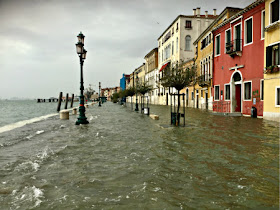 |
| Acqua alta on the Zattare in Venice - Photo: Cat Bauer |
There is a siren that goes off to warn the citizens of Venice that acqua alta is expected, which starts with a shattering air raid wail, then segues into four ascending harmonic tones that sound something like Close Encounters of the Third Kind. With each ascending tone, anxiety rises. We usually have one or two tones. Three is bad. Four is almost unheard of. Today we had four. On top of that, it has been raining on and off all day with strong, gusty winds.
 |
| Fallen trees by Accademia - Photo: Cat Bauer |
Only certain areas are lower than 100 cm -- the lowest point in Venice is right in front of the main entrance of the Basilica of San Marco in Piazza San Marco, which is 64cm, and always floods. But when we have exceptional high water -- over 140cm -- that means 90% of the town is covered by water.
Flood Rates of Venice in Relation to High Water Levels
+100cm - 3.56%
+110cm - 11.74%
+120cm - 35.18%
+130cm - 68.75%
+140cm - 90%
The information I am using from the Province of Venice's Turismo Venezia does not list tides over +140cm, but we can imagine that at +160cm, nearly the entire town is covered by water. This does not mean that we are under water, but there is water in almost every calle in town. Here is a photo of the calle outside my door, which never gets high water, even at +140cm. I was only millimeters away from the water coming in my house! I wonder if in the future there will always be water in the calle, and that to live in Venice you will have to put on rubber boots just to get out the door.
 |
| Water in the calle - Photo: Cat Bauer |
 |
| Intrepid travelers at Bar da Gino during acqua alta in Venice - Photo: Cat Bauer |
Here is a YouTube clip I filmed of the Zattare, which became part of the lagoon, and was not possible to navigate without thigh-high boots as early as 12:45pm.
Another four-alarm siren went off as I wrote this. The winds are gusting. Exceptional acqua alta is also on the agenda for tonight and tomorrow...
Go to the Province of Venice High Water Information Centre for more information.
Ciao from Venezia,
Cat Bauer
Venetian Cat - The Venice Blog






